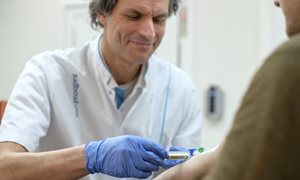
Researchers at the Radboudumc have shown that quality of life is better in women with a BRCA1 or BRCA2 mutation after a fallopian tube removal with delayed ovarian removal to prevent ovarian cancer. Because women with this mutation have an increased risk of ovarian cancer in addition to breast cancer, it is recommended that the fallopian tubes and ovaries be removed simultaneously around the age of forty, resulting in an early menopause. With treatment where only the fallopian tubes are removed first and the ovaries at a later date, women do not enter menopause early, which improves quality of life.
Women with a BRCA1 or BRCA2 mutation have an increased risk of developing ovarian cancer, which is 44% with BRCA1 and 17% with BRCA2. This is significantly higher than the risk for the average Dutch woman (1.3%). Moreover, ovarian cancer in an early stage gives few symptoms, it is not easy to diagnose early and the prognosis is often unfavorable. Women with a BRCA mutation are now advised to remove their fallopian tubes and ovaries around the age of 40 to reduce the risk of ovarian cancer. This is a very effective treatment, but can lead to many adverse effects. In fact, by removing the fallopian tubes and ovaries, women enter an early menopause, with various consequences both in the short term (hot flashes, night sweats, sexual problems) and in the long term (cardiovascular disease, osteoporosis and cognitive problems). These symptoms can result in a reduced quality of life and can only be partially resolved with hormones.
Large national study
In order to limit the early menopause and the reduced quality of life of this group of patients after such a preventive operation, the Radboudumc, with the support of KWF cancer control, launched a national study in 2015 on an alternative: removing the fallopian tubes, but leaving the ovaries in place for the time being. The 577 patients who participated in this study came from different UMCs and regional hospitals in the Netherlands. "In fact, there are very strong indications that ovarian cancer often develops not in the ovaries but in the fallopian tubes. By removing the fallopian tubes first and leaving the ovaries in place until the women are at most 45 years old (BRCA1) or 50 years old (BRCA2), we can delay menopause and thus improve quality of life," says Miranda Steenbeek, first author of the article now published in JAMA Oncology
Quality of life
The study found that women who opted for fallopian tube removal had a better menopause-related quality of life than women who had both the fallopian tubes and ovaries removed with the currently common treatment. Fallopian tube removal was also found to show an improvement over the group of women who used hormone therapy after standard treatment. Not only did the quality of life turn out better, but the sexual functioning of the women who were operated on according to the new method was also better. A very promising result. Within this study, quality of life was the main focus, but not yet whether it works to prevent ovarian cancer and what the impact is on the long-term effects of early ovarian removal, such as a higher risk of cardiovascular disease. So far, none of the patients have developed ovarian cancer after a fallopian tube removal, but the women have not been followed long enough to draw any conclusions from this. Because of the extensive safety regulations, this fallopian tube removal with delayed ovarian removal is only offered in a study setting. In order to determine the safety and influence on the prevention of ovarian cancer, a large international follow-up study has been started from the Radboudumc. The results of this study are expected in ten to fifteen years.
This study was conducted under the direction of Joanne de Hullu, Rosella Hermens and Nicoline Hoogerbrugge.
About the publication in JAMA Oncology
Salpingectomy with delayed oophorectomy instead of salpingo-oophorectomy to improve quality of life in BRCA1/2 carriers (TUBA study): a multicenter preference trial - Miranda P. Steenbeek, Marline G. Harmsen, Nicoline Hoogerbrugge, Marieke Arts-de Jong, Angela H.E.M. Maas, Judith B. Prins, Johan Bulten, Steven Teerenstra, Majke H.D. van Bommel, Helena C. van Doorn, Marian J.E. Mourits , Marc van Beurden, Ronald P. Zweemer, Katja N. Gaarenstroom, Brigitte F.M. Slangen, Monique M.A. Brood-van Zanten, M. Caroline Vos, Jurgen M.J. Piek, Luc R.C.W. van Lonkhuijzen, Mirjam J.A. Apperloo, Sjors F.P.J. Coppus, Leon F.A.G. Massuger, Joanna IntHout, Rosella P.M.G. Hermens, Joanne A. de Hullu.
-
Want to know more about these subjects? Click on the buttons below for more news.
More information
Pauline Dekhuijzen

wetenschaps- en persvoorlichter
Related news items

Tailored drug dosage for pregnant women
14 March 2022 Three quarters of women in the Netherlands use some form of medication during pregnancy, but little is known about the appropriate dosages. Research by the Radboudumc, MUMC+ and Lareb Mothers of Tomorrow should change this. read more
Ioannis Sechopoulos receives NWO Vici grant for research on improving breast cancer diagnostics
1 March 2022 Ioannis Sechopoulos will conduct research into improving tomosynthesis, an X-ray examination that radiologists use to detect breast cancer. read more
Body composition is more important than BMI for renal cancer survival rates
11 January 2022 Body composition is important for survival rates in renal cell cancer. Research from the Radboudumc shows that low muscle quality and low organ fat are associated with poor survival. This involves different stages of renal cancer, ranging from stage I-III to stage IV. read more
A single comprehensive DNA test of a tumor is usually sufficient
25 August 2021 A one-time measurement of the entire tumor DNA is almost always sufficient to find all DNA errors that are important for treatment. read more

